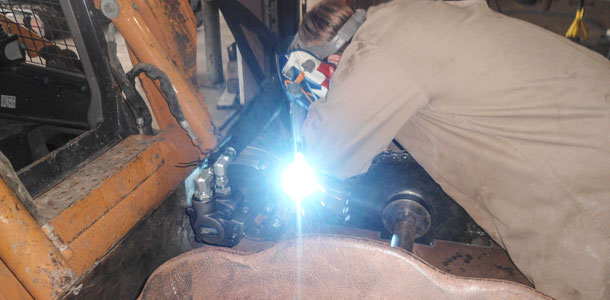Trey Kocurek’s uncle owns and operates a land improvement business across southern Texas. One component of that business includes tearing out or replacing barbed wire fencing. On a single project, Kocurek’s uncle planned to roll up and reuse 12 miles of three-strand barbed wire from a pasture choked with mesquite trees, cactus, dense brush and forbs. He wasn’t looking forward to it. But he had an idea for a hydraulically driven barbed-wire puller; he just didn’t have time to build it. So he enlisted Kocurek’s help.
Kocurek scavenged the chain drive, shaft and most of the sprockets from a cotton module truck. During cotton harvest, the harvester makes large bricks or bales of cotton approximately 15 to 20 feet high and 40 feet long. These huge bales are pulled into trucks using a hydraulic shaft and floor chain. Kocurek modified this system to design his barbed-wire puller.
The shaft Kocurek had scavenged from the cotton module truck had collected 30 years of rust and dirt, and many of the metal components were “frozen.” The original shaft had six or seven gears and three or four bearings that wouldn’t be required for the barbed-wire puller, and it took two days (of a total seven-day project) to grind off the rust and remove the accessories. Many cans of WD-40 later, with the shaft cleaned up, Kocurek realized the shaft was bent and couldn’t be used. So he started over.
The second attempt at cleaning another found shaft was successful. With the shaft ready, Kocurek turned his attention to the reel. Using 36-inch, well-worn disc blades, he stick-welded a length of 6-inch pipe between them to create a wheel.
Disc blades are hard and dense, and the first time Kocurek welded the pipe to it, the weld cracked. “Disc blades don’t weld too easily unless you get it really hot,” Kocurek says. “After two more tries, I finally got it to stick with a good, clean weld.”
It wasn’t his only do-over. His first paint job didn’t hold up well, either. Because he planned to enter this in the ag mechanics competition at the San Antonio Stock Show and Rodeo, Kocurek took the puller to a local shop to have it professionally sandblasted, which would also hold up better under regular use.

For the more minor welds, Kocurek used a MIG welder. Kocurek says, “I used a MIG welder for the little stuff because it’s easier for me and I can make it look nicer.” He used the MIG welder for welding brackets to the frame and mounting the motor to the bottom plate. With the main unit welded to a bare piece of metal, it was then attached to a quick-attach plate.
The unit fits on the front of a four-wheel drive, Bobcat skid steer with a front lift. The hydraulic motor for the puller runs off the hydraulic tractor pump that turns the shaft and chain drive.
The puller is activated by a switch from inside of the Bobcat, and the operator must remain inside the cab holding the switch to keep the reel turning. This was designed for safety reasons. Kocurek says he also put a metal cage on the skid steer to protect the operator in case the wire under tension snapped and flipped backward.
The initial practice run was successfully conducted on 200 feet of extension cord. For the field test, the post staples were pulled before hooking up the puller. Kocurek says it was a lot different pulling the wire through dense brush than it was pulling 200 feet of extension cord, but once they got the first tug and loosened the wire, the puller reeled in the wire without much trouble.
Kocurek was able to use several scrap pieces of metal and the used shaft, chain and discs. However, for contest purposes, he was required to value all materials (even scrap), factoring in all costs except labor. That figure came to $4,000.
“It wasn’t a complicated project but took a lot of time,” Kocurek says. “It’s not something everybody needs – it’s more of a purpose-built project.” His uncle, however, thinks it was well worth the cost and has used it several times in addition to the original 12-mile fence project.
Kocurek entered this project at the 2014 San Antonio show under the Chaparral 4-H Club umbrella, where he’s been active for the last 10 years with a variety of livestock and other projects under the leadership of Mary Truesdale in Robstown, Texas (Nueces County). He won second place with the hydraulic barbed-wire puller in the hydraulic equipment category. Kocurek is currently attending Texas A&M – Corpus Christi with plans to major in engineering. ![]()
Email Trey Kocurek for questions regarding his project.
PHOTOS
PHOTO 1: The barbed-wire puller is fashioned from worn discs, a scavenged chain drive, shaft and sprockets from a cotton module truck. It was then sandblasted for the final finish.
PHOTO 2: Trey Kocurek welds bare metal to a quick-attach plate to hold the barbed-wire puller on the front of a skid steer. Photos provided by Trey Kocurek.










